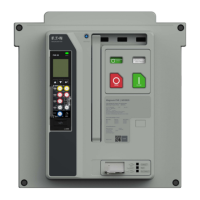26
6. Monitoring and testing
POWER XPERT® RELEASE TRIP UNIT FOR MAGNUM PXR CIRCUIT BREAKERS MN013015EN January 2022 www.eaton.com
6.3 Health monitor
The PXR trip unit includes an innovative algorithm to monitor
the health of the circuit breaker. The parameters that are
monitored by this algorithm include short circuits, overloads,
operations, temperature, and run-time. These parameters
can provide a host of individual insights while the combina-
tion of all of them provide an overall picture of the condition
of the breaker that can be used for preventative maintenance
and improved system reliability. This monitor is a tool and
is not a replacement for establish breaker maintenance or
replacement practices.
Figure 20. Health summary.
The health monitor feature is comprised of indices which
track the accumulated service performed by the circuit
breaker. The indices start at zero and are increased up to
10,000 points based on the conditions which the breaker
is operating within. The indices are retained in the frame
module of the circuit breaker, changing the trip unit will not
change the accumulated points.
The three indices tracked are:
•
Interruption wear – Trip events where there is an overload
or short-circuit of any level which opens the breaker.
This index increases as a function of current and system
voltage. The current is the RMS value used by the protec-
tion routines and is measured immediately before the
breaker is opened. The voltage is the measured system
voltage in PXR 25 or the system voltage setpoint in
PXR 20.
•
Operations – This index increases when the breaker
is mechanically operated (open-close or close-open)
independent of the current level. The breaker might be
operated due to an on-board secondary injection test, or a
communication command to open/close, or an accessory
or mechanical button release. Note that only operations
when the trip unit is powered will be counted.
•
Environmental – Time and temperature contribute to this
index. It increases more quickly when the temperature is
higher. Note that temperature is measured within the trip
unit. It increments by a small amount for every week that
the breaker is in operation. If the breaker is not operated
within a full year, additional points are added.
The health of the circuit breaker is summarized with a
health percentage calculated from the indices, with new
breakers reporting 100% health corresponding to 100%
remaining service life. The three indices are combined,
using the highest of the three indices when viewing on the
display in the Diagnostics Summary screen (bar graph) or
via a Modbus register (percentage), while in PXPM you may
observe each independently.
The health percentage may be mapped to one of the
configurable relays, closing the relay when the remaining
percentage is between 10 to 50% (configurable).
Circuit breakers operating under normal conditions and
reporting a health percentage below 100% have accumu-
lated service that is within its normal useful life. Periodic
maintenance should be performed throughout this period,
and in the absence of any signs of abnormal or excess
wear, damage or adverse environments, the circuit breaker
is considered suitable for continued use. As the health
percentage approaches zero, the circuit breaker should be
carefully evaluated to determine its suitability for continued
service. Based on accumulated service history, the circuit
breaker may be nearing the end of its normal service life
and a careful inspection should be performed to determine
actions required. The best practice is to plan for the replace-
ment of the circuit breaker, depending on its condition,
maintenance performed, and your site-specific maintenance
guidelines and standards.
If maintenance and inspections are preformed which
prolongs the serviceability of the circuit breaker, then you
may reset the indicies. Remember that the event counters
are not reset by the action of resetting any of the three
indices. Accumulated service will then be tracked by incre-
menting the indices from the new values, and the health
percentage will be recalculated.
6.4 Testing the circuit breaker and trip unit
The test functions do not require a separate test kit. A
battery of testing possibilities is available via the front panel
and using PXPM. Four built-in test modes are available for
use:
•
Functional test using secondary injection;
•
Functional test using simulated current;
•
Current sensor continuity test; and
•
Open breaker functional test.
Health summary
Diagnostics
Ok
I
n
=200

